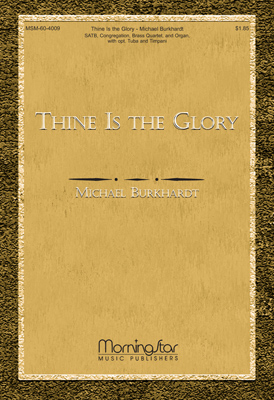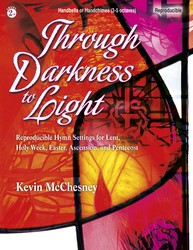- |
User Links
Thine Is the Glory

Thine is the glory, Risen, conquering Son
Translator: Richard Birch Hoyle; Author: Edmond Budry (1904)Tune: JUDAS MACCABEUS
Closing Songs
Published in 110 hymnals
Printable scores: PDF, MusicXMLPlayable presentation: Lyrics only, lyrics + musicAudio files: MIDI, Recording
Representative Text
1 Thine be the glory, risen, conqu'ring Son;
endless is the vict'ry Thou o’er death hast won.
Angels in bright raiment rolled the stone away,
kept the folded grave-clothes where Thy body lay.
Refrain:
Thine be the glory, risen, conqu'ring Son;
endless is the vict'ry Thou o’er death hast won.
2 Lo! Jesus meets us, risen from the tomb.
Lovingly He greets us, scatters fear and gloom;
let His church with gladness hymns of triumph sing,
for the Lord now liveth; death hath lost its sting. [Refrain]
3 No more we doubt Thee, glorious Prince of life!!
Life is nought without Thee; aid us in our strife;
make us more than conqu'rors, through Thy deathless love;
bring us safe through Jordan to Thy home above. [Refrain]
Source: Psalms and Hymns to the Living God #283
Translator: Richard Birch Hoyle
Born: March 8, 1875, Cloughfold, Lancashire, England. Died: December 14, 1939, Wimbledon, Surrey, England. Hoyle attended Regent’s Park College in London, then pastored in Sudbury, Aberdeen, and London (1900-17), and in Belvedere, Kent (1923-26). He edited the YMCA’s Red Triangle magazine, and was professor of theology at Western Theological Seminary, Pittsburgh, Pennsylvania (1934-36). He later returned to England, pastoring at the Baptist church in Kingston-on-Thames. Some of his work appears in the World Student Christian Federation hymnal Cantate Domino (1925). Translations: Holy God, Thy Name… Go to person page >Text Information
| First Line: | Thine is the glory, Risen, conquering Son |
| Title: | Thine Is the Glory |
| French Title: | A toi la gloire, O Resuscité |
| Author: | Edmond Budry (1904) |
| Translator: | Richard Birch Hoyle |
| Meter: | 5.5.6.5.6.5.6.5 |
| Language: | English |
| Refrain First Line: | Thine be the glory, risen conquering Son |
| Notes: | Spanish translation: See "Tuya es la gloria, victorioso Redentor" by Marjorie Caudill |
| Copyright: | Public Domain |
| Liturgical Use: | Closing Songs |
- Year A, Easter season, Easter Day
This is recommended for Year A, Easter season, Easter Day by 3 hymnal lectionary indexes including Glory to God: the Presbyterian Hymnal #238 and Lift Up Your Hearts: psalms, hymns, and spiritual songs #187. - Year A, Easter season, Easter Day
Related to John 20 (NPM) - Year A, Easter season, Easter Evening
This is recommended for Year A, Easter season, Easter Evening by 2 hymnal lectionary indexes including Glory to God: the Presbyterian Hymnal #238. - Year A, Easter season, Easter Evening
- Year A, Easter season, Second Sunday
This is recommended for Year A, Easter season, Second Sunday by 3 hymnal lectionary indexes including Glory to God: the Presbyterian Hymnal #238 and Lift Up Your Hearts: psalms, hymns, and spiritual songs #187. - Year A, Easter season, Second Sunday
- Year A, Easter season, Ascension of the Lord
- Year B, Epiphany season, Sixth Sunday
- Year B, Easter season, Easter Day
This is recommended for Year B, Easter season, Easter Day by 3 hymnal lectionary indexes including Glory to God: the Presbyterian Hymnal #238 and Lift Up Your Hearts: psalms, hymns, and spiritual songs #187. - Year B, Easter season, Easter Evening
This is recommended for Year B, Easter season, Easter Evening by 2 hymnal lectionary indexes including Glory to God: the Presbyterian Hymnal #238. - Year B, Easter season, Easter Evening
- Year B, Easter season, Second Sunday
This is recommended for Year B, Easter season, Second Sunday by 3 hymnal lectionary indexes including Glory to God: the Presbyterian Hymnal #238 and Lift Up Your Hearts: psalms, hymns, and spiritual songs #187. - Year B, Easter season, Third Sunday
This is recommended for Year B, Easter season, Third Sunday by 2 hymnal lectionary indexes. - Year B, Easter season, Third Sunday
- Year C, Easter season, Easter Vigil
This is recommended for Year C, Easter season, Easter Vigil by 2 hymnal lectionary indexes including Glory to God: the Presbyterian Hymnal #238 and Lift Up Your Hearts: psalms, hymns, and spiritual songs #187. - Year C, Easter season, Easter Day
This is recommended for Year C, Easter season, Easter Day by 3 hymnal lectionary indexes including Glory to God: the Presbyterian Hymnal #238 and Lift Up Your Hearts: psalms, hymns, and spiritual songs #187. - Year C, Easter season, Easter Evening
This is recommended for Year C, Easter season, Easter Evening by 2 hymnal lectionary indexes including Glory to God: the Presbyterian Hymnal #238. - Year C, Easter season, Easter Evening
- Year C, Easter season, Second Sunday
This is recommended for Year C, Easter season, Second Sunday by 3 hymnal lectionary indexes including Glory to God: the Presbyterian Hymnal #238 and Lift Up Your Hearts: psalms, hymns, and spiritual songs #187. - Year C, Easter season, Second Sunday
- Year C, Easter season, Third Sunday
- Year C, Ordinary Time, Proper 3 (8)
This is recommended for Year C, Ordinary Time, Proper 3 (8) by 2 hymnal lectionary indexes including Glory to God: the Presbyterian Hymnal #238 and Lift Up Your Hearts: psalms, hymns, and spiritual songs #187.
Chinese
English
- African Methodist Episcopal Church Hymnal #157
- Ambassador Hymnal: for Lutheran worship #98
- Ancient and Modern: hymns and songs for refreshing worship #218
- Anglican Hymns Old and New (Rev. and Enl.) #751
- Australian Hymn Book #303
- Baptist Hymnal 1991 #163
- Baptist Hymnal 2008 #138
- Celebrating Grace Hymnal #222
- Chalice Hymnal #218
- Christian Praise #71 10 shown out of 86
French
Korean
Spanish
Tune
JUDAS MACCABEUSJUDAS MACCABEUS is an arrangement of a tune from the chorus "See, the Conquering Hero Comes" in Handel's oratorio Judas Maccabeus (first performed without this chorus in 1746). Handel initially used the tune in his oratorio Joshua (1747) but transferred it to Judas Maccabeus in 1751; such changes we…
For Leaders
Text:
The lyrics for this hymn were written by Edmond Louis Budry in 1904. Budry was a Swiss minister, writer, and translator. The original text was in French, and was first translated into English by Richard Hoyle in 1925. It is believed that part of the inspiration for this hymn came after the death of his first wife. This hymn is inspired Christ’s resurrection and parts of Isaiah 25:8.
“Thine is the Glory” has become a favorite in Great Britain. This hymn is now a standard in the British Royal Family Easter services, is published in the Church of England’s funeral services hymn book, and is an integral part of the Last Night of the Proms concert season. Although fairly young, this hymn is certainly destined to stand the test of time.
Tune:
The tune for this hymn is JUDAS MACCABEUS. The title comes from the oratorio “Judas Maccabeus.” The tune comes from the chorus “See, the conquering hero comes.” When it was first released, the tune exploded in popularity. John Wesley mentioned several times in his Journal that the tune was one of his favorites. In 1796, Beethoven composed twelve variations of the tune for cello and piano. This tune has been paired with several texts, but it is by far most often used with “Thine is the Glory.”
When/Why/How:
This hymn is best used in an Easter morning service, although it is sometimes incorporated into weddings or funerals.
Suggested music for this Hymn:
- "Thine is the Glory"
- For the Choir, Brass or Organ: "Thine is the Glory"
Luke Getz Hymnary.org
Timeline
Arrangements
Media
- MIDI file from Baptist Hymnal 1991 #163
- MIDI file from The Cyber Hymnal #6635
- Audio recording from Evangelical Lutheran Worship #376
- Audio recording from Glory to God: the Presbyterian Hymnal #238
- Audio recording from Lift Up Your Hearts: psalms, hymns, and spiritual songs #187
- Audio recording from Lift Up Your Hearts: psalms, hymns, and spiritual songs #187
- Audio recording from The Presbyterian Hymnal: hymns, psalms, and spiritual songs #122
- Audio recording from Small Church Music #216
- Audio recording from Small Church Music #216
- Audio recording from The United Methodist Hymnal #308
- MIDI file from Worship and Rejoice #310


 My Starred Hymns
My Starred Hymns









